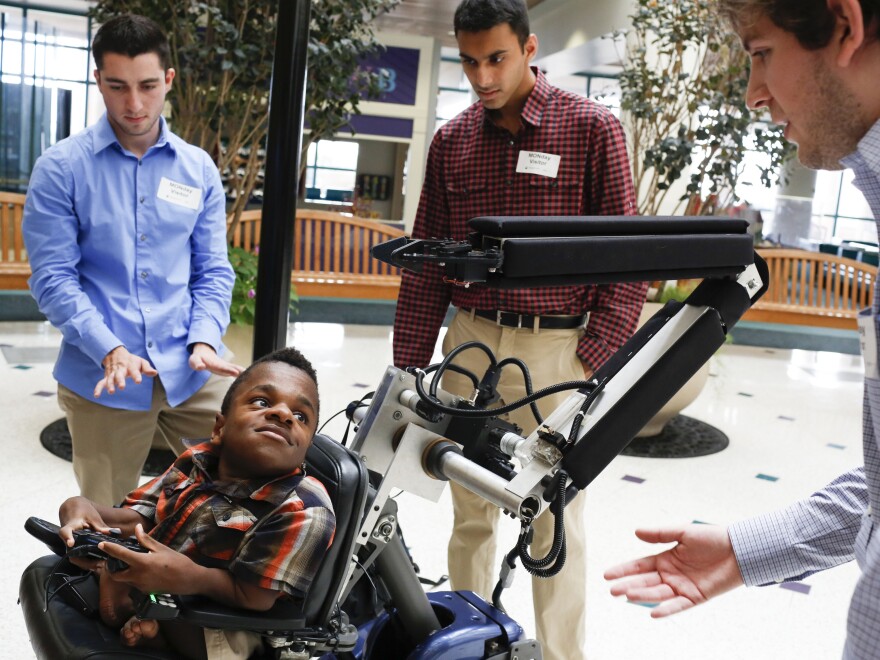Three engineering undergrads at Rice University gave a teenager with a rare genetic disease something he'd always wished for: the ability to turn off the light in his room.
It may not seem like much, but for 17-year-old Dee Faught, it represents a new kind of independence.
Dee can't operate a light switch because he can't reach far enough from his wheelchair. He has a disorder called osteogenesis imperfecta, also known as brittle bone disease. In addition to breaking easily, Dee's bones are tiny. His legs and arms are all twisted up.
The three Rice students heard about Dee in an unusual freshman engineering class. Instead of learning engineering principles from a book, students form teams to come up with engineering solutions for real-world problems.
The team's first step was to meet their client.
"We walked through Shriner's Hospital for Children," says Nimish Mittal, one of the trio. "One of the nurses led us to this patient room, and right smack dab there in the center was Dee sitting there in his wheelchair, with just a big smile on his face, waiting to see us."
"It was very surprising seeing how small he was at 15 years old at the time," says Matthew Najoomi, the second member of the team. "I guess it was a little bit emotional when we first met him, because we felt bad for him being a teenager. We'd been through that phase. And on top of that, he has to deal with brittle bone disease. And we wanted to do as much as we could to relieve that."

At first, Mittal says, they were planning to build him something simple, like a reaching stick of some sort. "But when we met Dee we were all really excited and we said, no, we need to go all out and do the best thing we could possibly do for him," he says.
So the team decided to make a portable robotic arm that would attach to Dee's wheelchair so he could reach things all around him. At the end of the arm there would be some kind of gripper Dee could use to pick things up.
Rice has a well-equipped lab for engineering students called the Oshman Engineering Design Kitchen where the trio could work on the arm. The project didn't look that hard on paper, but when they actually started building the arm, "We hit a ton of roadblocks," says Sergio Gonzalez, the third member of the trio. "At the beginning we were working on what design we should use for the gripper. Like would it be like a scoop thing? Would it be sort of like this claw? Would it be three prongs? Would it be two prongs? Would it look exactly like a hand and have five digits and clamps around something?"
In the end they decided on something that looked like pair of pincers with flat paddles at the end. But there was just one problem: The gripper kept dropping things.

And there was an even bigger problem. The arm wasn't nearly finished, but the engineering course was ending. But the team members say the idea of not finishing the project never entered their minds.
"We had someone who came and sat down in front of us, and asked for our help," says Najoomi.
"We had to finish something for Dee," says Mittal. "We couldn't honestly leave this project because we would have left Dee hanging."

So the class ended, and the team kept going.
All the rest of their freshman year, through the summer and the next school year, the trio kept at it.
Finally, they cracked the gripper problems. "We changed the materials we used at the end," says Mittal. "We changed the angle at which it was touching the objects; we made it a little bit bigger so there's more contact with the objects that we were picking up."
At the end of September, two years after they first got the assignment, Najoomi, Gonzalez and Mittal delivered a working model of the robotic arm to Dee.
When the team handed the arm controller to Dee, he got the hang of it right away.
"I picked up a towel," says Dee. "I picked up hats, and then I picked up a shirt. And I picked up stuff like a cup, an orange and a book." Just normal stuff. Boring, really, but not for Dee. "It was actually the coolest thing ever."
No more will he have to ask for help to turn off the light in his room.
For the engineering undergrads, the project could have life-changing consequences, too.
"This has definitely refined the engineering I want to do," says Gonzalez. "Because it's an engineering focused on helping people."
Mittal agrees. "I definitely want to continue this kind of work throughout my life," he says.
"It's been a lot of sacrifice timewise on our end," says Najoomi. But "it pales in comparison to how rewarding it is to see him actually use [the arm] and smile."
Copyright 2021 NPR. To see more, visit https://www.npr.org. 9(MDIxMDkyNjUxMDE0NDY1Njg1NzRiOTRiYQ000))






